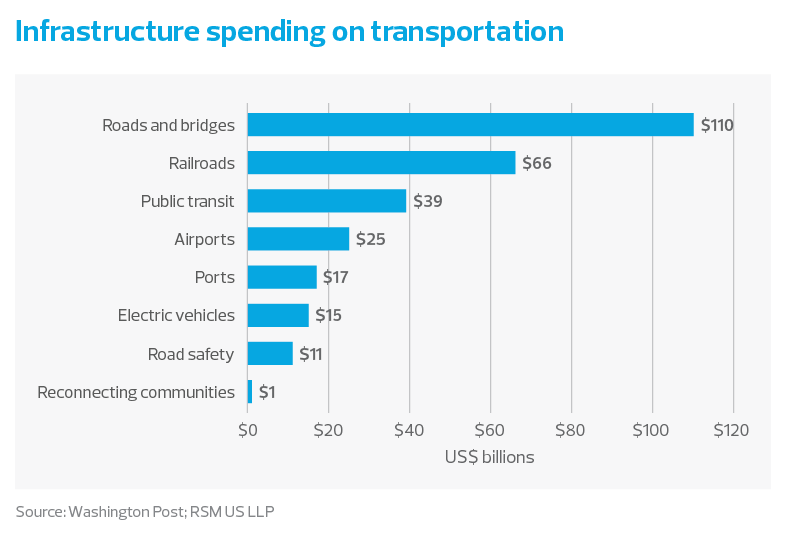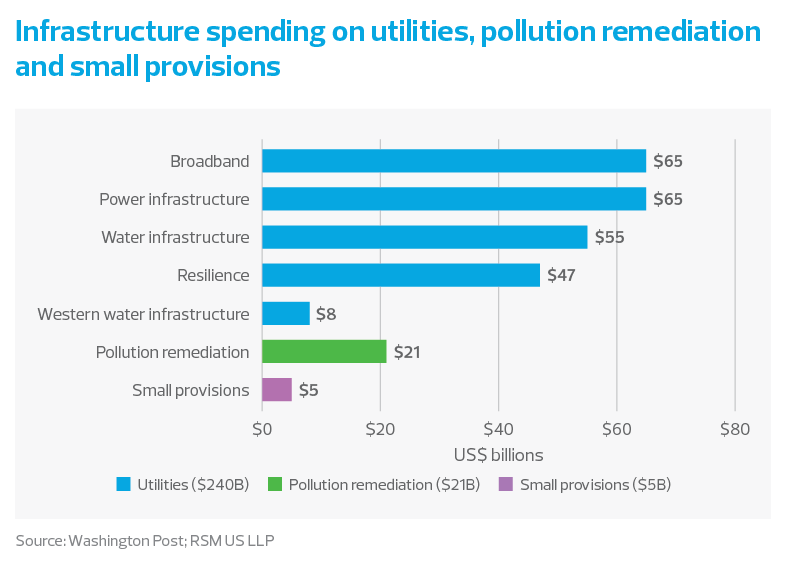Resources
The $1.2 trillion infrastructure legislation and the middle market
ARTICLE | January 04, 2022
Authored by RSM US LLP
The $1.2 trillion Infrastructure Investment and Jobs Act signed into law by President Biden will increase productivity, reduce business costs, cut carbon emissions, improve living standards and have the potential to lift economic growth above the current long-run rate of 1.8%.
Once one accounts for spending at the state and local level, infrastructure spending will reach nearly $3 trillion over the next eight years. This represents the most significant modernization of the nation’s infrastructure since the middle of the 20th century.
There are near-term macroeconomic benefits to infrastructure investment—the multiplier effect with real interest rates being negative is likely larger than the 1.25 per dollar spent on traditional hard infrastructure. But the most encouraging benefit of the initiatives will take place over the long run as they bring a payoff to both productivity and growth that will be greater than our estimate suggests.
While most ignore productivity in the near term, in the long run, it is everything. The dynamism and vitality of the domestic economy depend upon it.
The long-run benefits make this infrastructure package distinct from almost all other fiscal policies in recent years. Spending on broadband, roads, bridges, power and water systems, and public transit will receive the largest boost.

For example, the infrastructure law in its first year of implementation will only add $16 billion in net fiscal firepower to the economy. This bill will spur an increase in growth through the productivity channel that will dampen inflationary pressures over the medium to long run and not create undue fiscal constraints.
It is important to remember that the American economy generates roughly $23 trillion per year in overall activity. The $550 billion in new spending on top of the expected $2.4 trillion in investment around the remainder of the economy is not only necessary, but we can also afford it.
Academic research over the past three decades shows that for each 10% increase in infrastructure investment, national output grew by 0.8% in the near term and 1.2% in the long run.
Similar scholarly work implies that a 1% increase in public capital investment in hard infrastructure results in a 0.24% increase in productivity. This law should create roughly 675,000 temporary construction jobs over the next 10 years and reduce the unemployment rate by roughly 0.3%.
Given that almost all construction jobs are temporary—it has and will always be this way—only a fraction of those jobs will result in permanent employment. Should labor growth in the United States continue at a restrained pace below 0.5% a year, demand for labor in the construction industry will reach a point where wages will be bid up and firms will begin looking at guest workers and immigrants to fill basic needs.
In our analysis, the greatest challenge to the modernization of American infrastructure will be a tight labor market, and not financial constraints, interest rates or medium- to long-term inflation risks.
While this law will add modestly to the federal deficit, investments that will boost productivity and growth over that period are in the interest of the economy and are strongly supported by the firms that populate the real economy.
In a recent RSM US survey of middle market executives that asked their views on infrastructure, roughly 63% of senior executives said that the state of the nation’s infrastructure is holding back the national economy, 60% said that it was hurting their local economy and 54% noted that it was restricting the growth of their organization.
This kind of consensus in the commercial community is uncommon, and the bipartisan legislative agreement represents an encouraging next step to repair the nation’s critical infrastructure.

The takeaway
Each year, American states and territories spend roughly $170 billion a year on infrastructure. Over the next 10 years, the new spending, in addition to the congressional baseline established under law, will result in roughly $2.9 trillion in infrastructure investment. That represents the single largest modernization of U.S. infrastructure since the Eisenhower-Kennedy-Johnson era of the 1950s and 1960s. Since that time, public investment in domestic infrastructure has declined by roughly 40%. The new investments are long overdue. The American people, and the businesses that power the real economy, will benefit.
Let's Talk!
Call us at (325) 677-6251 or fill out the form below and we'll contact you to discuss your specific situation.
This article was written by Joe Brusuelas and originally appeared on Jan 04, 2022.
2022 RSM US LLP. All rights reserved.
https://rsmus.com/insights/economics/the-1-2-trillion-infrastructure-legislation-and-the-middle-marke.html
RSM US Alliance provides its members with access to resources of RSM US LLP. RSM US Alliance member firms are separate and independent businesses and legal entities that are responsible for their own acts and omissions, and each is separate and independent from RSM US LLP. RSM US LLP is the U.S. member firm of RSM International, a global network of independent audit, tax, and consulting firms. Members of RSM US Alliance have access to RSM International resources through RSM US LLP but are not member firms of RSM International. Visit rsmus.com/about us for more information regarding RSM US LLP and RSM International. The RSM logo is used under license by RSM US LLP. RSM US Alliance products and services are proprietary to RSM US LLP.

Condley and Company, LLP is a proud member of the RSM US Alliance, a premier affiliation of independent accounting and consulting firms in the United States. RSM US Alliance provides our firm with access to resources of RSM US LLP, the leading provider of audit, tax and consulting services focused on the middle market. RSM US LLP is a licensed CPA firm and the U.S. member of RSM International, a global network of independent audit, tax and consulting firms with more than 43,000 people in over 120 countries.
Our membership in RSM US Alliance has elevated our capabilities in the marketplace, helping to differentiate our firm from the competition while allowing us to maintain our independence and entrepreneurial culture. We have access to a valuable peer network of like-sized firms as well as a broad range of tools, expertise and technical resources.
For more information on how Condley and Company can assist you, please call (325) 677-6251.
